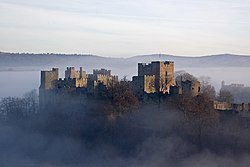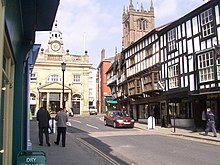Ludlow
| Ludlow | |
| Shropshire | |
|---|---|
 Ludlow Castle | |
| Location | |
| Grid reference: | SO517750 |
| Location: | 52°22’5"N, 2°43’3"W |
| Data | |
| Population: | 10,500 |
| Post town: | Ludlow |
| Postcode: | SY8 |
| Dialling code: | 01584 |
| Local Government | |
| Council: | Shropshire Council |
| Parliamentary constituency: |
Ludlow |
Ludlow is a beautiful market town in Shropshire, built on a steep hill above a bend in the River Teme. It is a mediæval walled town, retaining its ancient character and charm. Ludlow formerly served as the seat of the Council of Wales and the Marches; effectively Capital of Wales.
At the crown of the hill stands Ludlow Castle and the market place beside it. The streets slope downward to the River Teme, and northward toward the River Corve. The town is in a sheltered spot beneath the Clee Hills which are clearly visible from the town.[1] With a population of around 10,000, Ludlow is the largest town in southern Shropshire and the local centre for the villages for many miles around.
Ludlow has nearly 500 listed buildings.[2] They include some fine examples of mediæval and Tudor-style half-timbered buildings including the Feathers Hotel. The parish church, St Laurence, is the largest in the county.[3]
Country Life magazine described Ludlow as "the most vibrant small town in England."[4]
Contents
Name
Ludlow stands between two cultures, its name in Welsh being "Llwydlo" Its name derives from the Old English Hludhlaw meaning "Loud Waters Hill", referring to the rapids over which the River Teme beat in former days.[5] The Welsh name Llwydlo was in use before 1138.. At some time around the 12th century, weirs were added along the river, taming these rapid flows. Later in the same century the larger outer bailey was added to the castle.
History
Mediæval history
The town is close to Wales and also very close to the county border between Shropshire and Herefordshire; it was listed with the Herefordshire entries in the Domesday Book. This strategic location invested it with importance in the Middle Ages and its large castle remains largely intact. Ludlow Castle was the seat of the Council of Wales and the Marches and a temporary home to several Princes of Wales, including the future King Edward IV and Arthur Tudor, who died there in 1502 at the age of 15.
At the time of the Domesday Book survey Ludlow was the location of the unoccupied large Stanton Manor, a possession of Walter de Lacy. Walter's son Roger de Lacy began the construction of a castle on the crest of the hill between about 1086 and 1094, forming what is now the inner bailey. Between about 1090 and 1120, the Chapel of St Mary Magdalene was built inside the walls, and by 1130 the Great Tower was added to form the gatehouse. The castle was an important border fortification along the Welsh Marches, and played a significant role in local, regional and national conflicts such as the Owain Glyndwr rebellion, the Wars of the Roses and the English Civil War.
Marcher town
The town also provided a useful source of income for successive Marcher Lords, based on rents, fines, and tolls. They developed the town on a regular grid pattern, although this was adapted somewhat to match the local topography. The first road was probably High Street, which formed the wide market place to the east of the castle gates. The town continued to grow, joining an old north-south road, now called Corve Street to the north and Old Street to the south. Mill Street and the wide Broad Street were added later.
The town was licensed to build a defensive wall in 1233. It was constructed about the central part of the community with four main gates and three postern gates. The castle complex continued to expand (a Great Hall, kitchen and living quarters were added) and it gained a reputation as a fortified palace. In 1306 it passed through marriage to the ambitious Roger Mortimer, 1st Earl of March. Queen Isabella and her son, the young Edward III, were entertained at the castle in 1328.
The town prospered, and sustained population of about 2,000 for several centuries. It was a market town; market day was held on every Thursday throughout the 15th century. In particular, it served as a centre for the sale of wool and cloth. It was home to various trades, and in 1372 boasted 12 trade guilds including metalworkers, shoemakers, butchers, drapers, mercers, tailors, cooks and bakers. There were also merchants of moderate wealth in the town and especially wool merchants, such as Laurence of Ludlow, who lived at nearby Stokesay Castle. The collection and sale of wool and the manufacture of cloth continued to be the primary source of wealth until the 17th century. Drovers roads from Wales led to the town.
This prosperity is expressed in stone and stained-glass as St Laurence's parish church. It is a wool church and the largest in Shropshire. Despite the presence of some Decorated work it is largely Perpendicular in style.[6]
The town also contained several coaching inns such as the Old Angel on Broad Street, public houses and ale houses, leading to court records of some alcohol-induced violence and a certain reputation for excess. Several coaching inns were constructed to accommodate travellers by stagecoach and mail coach. The oldest surviving inn today is the 15th century Bull Hotel on the Bull Ring.
During the Wars of the Roses, Richard, Duke of York, seized the castle and turned it into one of his main strongholds. The Lancastrian forces captured Ludlow in 1459, but at the end of the conflict in 1461 the castle became property of the Crown and passed to Richard's son, Edward IV. The town was then incorporated as a borough. Edward established the Council of Wales and the Marches in 1473 and sent his son, Edward, Prince of Wales, to live there, as nominal head of the Council. It was at Ludlow that the prince heard the news of his father's death and was himself proclaimed King Edward V of England.
Early modern period
Under Henry VII the castle continued as the headquarters of the Council of Wales and served as the administration centre for Wales and the counties along the border, the Welsh Marches. During this period, when the town served as the effective capital of Wales, it was home to many messengers of the king, various clerks and lawyers for settling legal disputes. The town also provided a winter home for local gentry, during which time they attended the Council court sessions. Henry VII also sent his heir Prince Arthur to Ludlow, where he was joined briefly by his wife Catherine of Aragon later to become wife to Henry VIII, who was living in Castle Lodge, Ludlow at the time. Ludlow Castle was therefore the site of perhaps the most controversial wedding night in history, when Catherine's claim that the marriage was never consummated became central to the dispute over Henry VIII and Catherine's annulment in 1531.
After 1610, the cloth industry declined but the wealth of the town was little affected until about 1640, when the activities of the Council were suspended and the town's population promptly fell by 20%.
Eventually, the Council resumed and except for brief interludes, Ludlow continued to host the Council until 1689, when it was abolished by William and Mary. The castle then fell into decay. The structure was poorly maintained and stone was pillaged. In 1772 demolition was mooted, but it was instead decided to lease the buildings. Later still it was purchased by the Earl of Powis, and together, he and his wife directed the transformation of the castle grounds.
Later history
From 1760, the population began to undergo a significant expansion. New structures were built along the outskirts that would become slums in the 19th century and later, torn down.
By the 20th century, Ludlow had seen a growth in tourism, leading to the appearance of many antique dealers, as well as art dealers and independent bookshops (now mostly gone). Many of the traditional shops were acquired by retail chains, and a long battle of words between local activists and local companies and Tesco was eventually won by the mega retailer when it obtained planning permission to build a supermarket on Corve Street, but Bodenham's, a clothing retailer, survives and is one of the oldest shops in the country – it celebrated its 600th anniversary in 2005.[7]
Culture
The legend of Fulk FitzWarin
Ludlow castle is central to the folk-story of Fulk FitzWarin, the outlawed Lord of Whittington, Shropshire and a possible inspiration for the Robin Hood legend.
Fulk, we are told, is brought up in the castle of Joce De Dynan, and fights for his master against Sir Walter de Lacy – these battles are also the source of the story of Marion de la Bruyere, the betrayed lover whose ghost is still said to be heard crying as she plummets from the castle's turrets.
Festivals and fayres
The Ludlow Festival has been held annually since 1960, during the end of June and the start of July each year. An open area within the castle serves as the stage and backdrop for various Shakespearean plays, while a number of supporting events at various venues include classical and pop/rock concerts, varied musicians, lecture talks from public figures, and entertainers.
The annual Ludlow Marches Festival of Food & Drink is a food festival that takes place in and around Ludlow in September. Centred on Ludlow Castle, where over 150 local, small food producers showcase and sell their wares, the three-day event involves the town centre in food and drink trails including the famous "Sausage Trail".[8]
The Mediæval Christmas Fayre is another annual event in Ludlow taking place during late November, again centred on Ludlow Castle and the market square.[9]
Gastronomy
Ludlow has become a gastronomic centre and at one point was the only town in England with three Michelin-starred restaurants[10] (a distinction lost to Bray in Berkshire), but Ludlow still holds two Michelin starred establishments, and eight AA-Rosette-starred restaurants. The town hosts the prestigious annual Ludlow food festival. Ludlow is the first British member of Cittaslow or "slow food" movement,[11][12] and is at the forefront of the "slow movement" network in Britain.
Ludlow supports three traditional butchers, four bakers, a regular farmers' market and a range of specialist food shops. The town has its own brewery, which has been producing real ale (using local hops) since 2006.[13]
Ludlow images
References
- ↑ "Ludlow". http://www.scit.wlv.ac.uk/~jphb/shropshire/Ludlow_General.html. Retrieved 2007-09-10.
- ↑ "Ludlow's Buildings". http://www.ludlow.org.uk/arch.html. Retrieved 2007-09-17.
- ↑ Mawer, Fred (2006-10-04). "Getting a Taste for Ludlow". The Daily Telegraph (London). http://www.telegraph.co.uk/travel/main.jhtml?xml=/travel/2006/10/04/etludlow04.xml. Retrieved 2007-09-17.
- ↑ "Ludlow Tourist Information". http://www.shropshiretourism.info/ludlow/. Retrieved 2007-09-17.
- ↑ Room, Adrian (2003). Placenames of the World: Origins and Meanings. McFarland. ISBN 0786418141.
- ↑ "St. Laurence's Church". http://www.stlaurences.org.uk/. Retrieved 2007-11-10.
- ↑ "Association of Convenience Stores". http://www.acs.org.uk/en/Press_Office/details/index.cfm/type/archive/obj_id/F0091D68-0F17-453E-BF471BBBB5066E72. Retrieved 2007-11-10.
- ↑ "Ludlow Food Festival". http://www.foodfestival.co.uk/. Retrieved 2007-11-10.
- ↑ "Ludlow Mediæval Christmas Fayre". http://www.ludlowcraftevents.co.uk. Retrieved 2008-08-15.
- ↑ "Ludlow Shropshire tourist and visitor information". http://www.touruk.co.uk/shropshire/ludlow.htm. Retrieved 2007-09-17.
- ↑ "UK Cittaslow Website". http://www.cittaslow.org.uk. Retrieved 2007-11-10.
- ↑ "Woman's World - Going slow in Ludlow". http://womans-world.co.uk/going-slow-in-ludlow.html. Retrieved 2007-09-17.
- ↑ Ludlow Brewing Co.
Outside links
- Geograph - photos of Ludlow and surrounding areas







